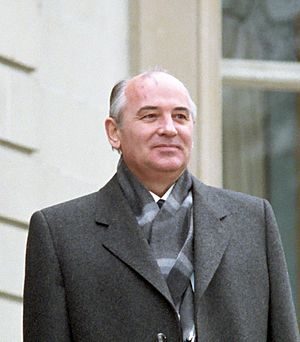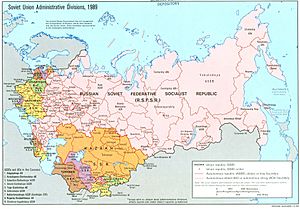History of the Soviet Union (1985-1991) facts for kids
The history of the Soviet Union from 1985 to 1991 is about the time when the Soviet Union broke apart. This means it stopped being one big country. Before 1991, the Soviet Union was made up of many regions called "republics." These republics had been part of the Russian Empire before 1917. After the Soviet Union broke up, all these republics became independent countries.
Some of these new countries are Armenia, Azerbaijan, Belarus, Kazakhstan, Kyrgyzstan, Moldova, Tajikistan, Turkmenistan, Ukraine, Uzbekistan, Georgia, Estonia, Latvia, and Lithuania. Russia is also a new country, but it still has many former republics inside its borders. That's why it's called the Russian Federation.
The Soviet Union officially ended with the creation of the Commonwealth of Independent States. Mikhail Gorbachev was the president of the Soviet Union at the time. He became leader on March 11, 1985. On December 25, 1991, he resigned. By December 31, 1991, all parts of the Soviet government had stopped working. The Soviet flag was lowered from the Kremlin for the last time.
Contents
Why the Soviet Union Changed
Between 1969 and 1982, not much changed in the Soviet Union's politics or economy. Its relationship with the United States also got worse when the Soviet war in Afghanistan began. Some people think this led the Soviet Union to start making big changes.
In March 1985, Mikhail Gorbachev became the leader of the Communist Party. He and a new group of leaders started to change the Soviet Union's politics and economy. They also tried to improve relationships with Western countries like the United States.
At that time, the Soviet economy was okay, but it was slower than Western economies. Also, it cost a lot of money to keep the Soviet Union as a superpower. This included paying for a large military, spy networks like the KGB, and helping countries close to them. The Soviet Union was also falling behind in technology. Many factories used old machines, and they were behind in computer technology.
Because of these problems, Gorbachev and his team started three important policies:
- Glasnost – This meant "political openness." It allowed more freedom of speech.
- Perestroika – This meant "economic changes" or "restructuring." It aimed to fix the economy.
- Uskoreniye – This meant "speeding up" economic development.
Big Changes Happen

For a long time, Soviet citizens couldn't own private property or businesses. The government owned almost everything. But in 1988, the government allowed people to own some types of businesses. These included shops, restaurants, and small factories.
Glasnost gave people more freedom to speak their minds. They could even criticize the government, which was new. The government also reduced censorship, meaning they controlled less of what was published. Many political prisoners were set free. In 1987, Gorbachev started making Soviet politics more democratic. In 1988, he began to reduce the Communist Party's control over the government.
In December 1988, a new law-making body was created called the Congress of People's Deputies. Elections for this body took place in 1989. On March 15, 1990, the members elected Gorbachev as the first executive President of the Soviet Union.
Unexpected Results
Many of Gorbachev's changes had unexpected results. The policies of perestroika and glasnost, which were meant to make the Soviet economy stronger, actually led to something very different. Many things happened together that eventually caused the Soviet Union to break apart.
Under Glasnost (political openness), the government and Communist Party lost control over the media. A free media showed the public many bad things about Soviet society and the economy. People learned about poor housing, old factories, and corruption. They also learned about crimes committed by Stalin, like the prison camps called Gulags and the large number of killings. People also found out more details about the war in Afghanistan and the nuclear accident at Chernobyl. The Soviet Union had not admitted to the Chernobyl accident until three days after it happened. All these negative stories made people lose faith in the Soviet system and communism.
By 1989, the Soviet government found it too hard to control its Eastern European allies. These countries had been ruled by communist governments with Soviet support since World War II. The Soviet Union decided to let them choose their own futures. This led to communist governments falling in countries like Bulgaria, Czechoslovakia, East Germany, Hungary, Poland, and Romania by 1990.
Seeing all these changes, many "republics" within the Soviet Union also wanted to become independent. The Glasnost policy also allowed a strong feeling of nationalism to grow in these republics, which the Soviet government had tried to hide for a long time. Some republics quickly tried to become independent.
The leaders thought Perestroika was a bold step to improve the economy. But the changes weren't strong enough to fix the bad economic problems of the 1980s. Even with many changes, Gorbachev and his team left some parts of the Soviet economy unchanged. For example, the government still controlled prices and most production. By 1990, the economy got even worse.
Here are some examples of the problems:
- Government spending increased.
- Tax money coming in went down because republics stopped paying taxes.
- Money from selling vodka decreased because many people stopped drinking.
- The government still had to support farms and industries that weren't making money.
- The government removed some controls but didn't make other changes needed for a smooth move from a state-controlled economy to a free one. This caused problems like low production.
The Soviet Union Breaks Apart
On February 7, 1990, the Communist Party was forced to give up some of its power. Around the same time, different "republics" of the Soviet Union started to say they had the right to be independent. They stopped following the laws of the central Soviet government. They also stopped paying taxes to Moscow. This made the Soviet government and economy much weaker.
In 1990, when Gorbachev visited Vilnius, the capital of Lithuania, about 250,000 people protested. On March 11, 1990, Lithuania declared its independence from the Soviet Union. However, the Soviet government demanded that Lithuania give up its independence and kept many Soviet Army troops there. The Soviet Union also blocked trade with Lithuania. Estonia and Latvia, which the Soviet Union had taken over in 1940, also declared their independence in March and May 1990.
On March 17, 1991, people in the Soviet Union voted on whether to keep the Soviet Union in a slightly changed form. The Baltic States (Lithuania, Estonia, Latvia), Armenia, Georgia, and Moldova did not take part in the vote. In the other nine "republics," most voters supported keeping the Soviet Union. In June 1991, an election took place in the Russian Republic. Boris Yeltsin, who was a critic of Gorbachev, won with 57% of the vote.
The Coup Attempt
The "republics" of the Soviet Union had agreed to sign a new agreement on August 20, 1991. This agreement would make them almost independent but still part of a federation with a common president, foreign policy, and military. However, some people disagreed. Some wanted a quick move to a market economy, even if it meant the Soviet Union breaking up. Others in the Communist Party and military wanted the Soviet Union to continue as it was.
On August 19, 1991, some senior Soviet leaders formed a "State Committee on the State Emergency." They stopped the agreement from being signed. These leaders included Gorbachev’s vice president, Gennadi Yanayev, the prime minister, and the head of the KGB. Gorbachev was on holiday in Crimea and was put under house arrest. The coup leaders also banned all political activities and most newspapers.
This was like a coup, an attempt to take power by force. The organizers expected people to support them, but they didn't. Instead, people supported Boris Yeltsin's office, known as the "White House." The coup organizers tried but failed to arrest Yeltsin. After three days, on August 21, the coup failed. The organizers were arrested. Gorbachev returned as president, but his real power had greatly decreased.
After the coup failed, the republics of the Soviet Union tried even harder to become independent. On September 6, 1991, the Soviet Union officially recognized the independence of Estonia, Latvia, and Lithuania. On December 1, 1991, Ukraine declared its independence after 90% of its voters chose to be independent. This was a huge blow to keeping the Soviet Union together, as Ukraine was the second most powerful "republic" after Russia. One by one, the remaining eleven "republics" also declared themselves independent.
The CIS is Formed
As mentioned, the Soviet Union recognized the independence of Estonia, Latvia, and Lithuania on September 6, 1991. By December 17, 1991, twelve of the fifteen Soviet republics had signed an international agreement in the Hague. This showed that these republics had practically become independent countries.
Leaving out Estonia, Latvia, and Lithuania, the remaining 12 republics (all except Georgia) joined the Commonwealth of Independent States (CIS). Georgia later joined the CIS in December 1993.
Many people believe that the creation of the Commonwealth of Independent States meant the Soviet Union no longer existed. They see it as the final step in the dissolution of the Soviet Union. Others think that with the CIS, Russia still has some control over the former Soviet republics.
On December 25, 1991, Gorbachev resigned as president of the USSR. By December 31, 1991, all official Soviet government groups had stopped working in the different "republics." The individual governments of these republics started running things. The Soviet flag flew over the Kremlin for the last time.
What Happened After the Breakup
Right after the Soviet Union broke up, Boris Yeltsin, the leader of Russia, took many steps to change the economy. He wanted to move from a socialist economy (where the government controls everything) to a capitalist economy (where private businesses are important). For example, he stopped giving money to farms and industries that were losing money. He also removed price controls and allowed the Russian currency to be traded freely. He also allowed many people close to him and other business people to take over businesses and industries that the government used to own.
People thought these changes would lead to faster economic growth. However, that didn't happen right away.
Since the Soviet Union broke up, Russia has faced many problems:
- About 25% of the population in Russia is now very poor.
- People's life expectancy (how long they live) has gone down.
- The country's total economic output (Gross Domestic Product) became about half of what it used to be.
Many older Russians believe that the old system was better. During the 1990s, Russia faced many political, social, and economic problems. Some people still believe that the situation is worse now compared to before the Soviet Union ended.
Other pages
See also
 In Spanish: Historia de la Unión Soviética (1985-1991) para niños
In Spanish: Historia de la Unión Soviética (1985-1991) para niños


